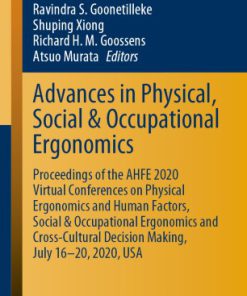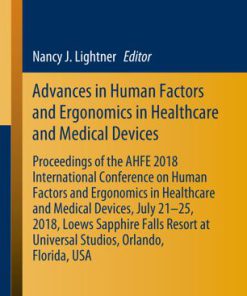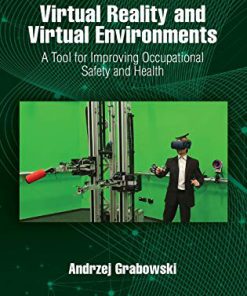Advances in Social and Occupational Ergonomics 1st Edition by Richard Goossens ISBN 9783319416885 331941688X
$50.00 Original price was: $50.00.$25.00Current price is: $25.00.
Advances in Social and Occupational Ergonomics 1st Edition by Richard Goossens – Ebook PDF Instant Download/Delivery: 9783319416885 ,331941688X
Full download Advances in Social and Occupational Ergonomics 1st Edition after payment

Product details:
ISBN 10: 331941688X
ISBN 13: 9783319416885
Author: Richard Goossens
Advances in Social and Occupational Ergonomics 1st Edition Table of contents:
1 The Usage of Simulation Technology for Macroergonomic Industrial Systems Improvement
Abstract
1 Introduction
2 Peculiarity and Prerequisites of Macroergonomic Industrial Systems Improvement
3 Progress and Results of the Project
3.1 Reasons, Aims and Method of the Macroergonomic System Improvement
3.2 The Problem of the Balanced Production Line
3.3 The Simulation Tools Use and the Project Results
4 Conclusions
Acknowledgments
References
2 3D Laser Models for the Ergonomic Assessment of the Working Environment
Abstract
1 Introduction
2 Frames of 3D Scanning Technology
3 Application of 3D Scanning Technology in Safety Engineering and Ergonomics
4 Application of 3D Scanning Technology in Ergonomic Assessment
5 Conclusion
References
3 A Multi-Criterial Hardware Assessment of the Psychophysical Capacity of Workers in the Investigati
Abstract
1 Introduction
2 Measuring Device Descriptions
3 Results of Experimental Tests
4 Conclusions
References
4 The Maintenance Management in the Macro-Ergonomics Context
Abstract
1 Introduction
2 Macro-Ergonomics
3 Future Manufacturing and Human Factor
4 Maintenance Management
4.1 Maintenance Objectives
4.2 Maintenance Technology
4.3 Maintenance Staff
5 Summary
References
5 Agreement for Safety in the Building Sector as a Good Practice to Improve Safety in the Work Envir
Abstract
1 System of Labor Protection in Poland
2 Construction Sector to Improve
3 Agreement for Safety in the Building Sector
3.1 Areas of Action [13]
4 Improving Work Safety on Construction Sites
References
6 A Process-Oriented Design Knowledge Management Method
Abstract
1 Introduction
2 Product Design Knowledge
3 Knowledge Modeling Method Based on Knowledge Property
3.1 The Definition of Knowledge Property
3.2 Knowledge Representation Model
4 Knowledge Acquirement Based on the Design Processes
4.1 Customers’ Requirements Analysis Phase
4.2 Product Function Analysis Phase
4.3 Product Structure Analysis Phase
5 Example
6 Conclusion
Acknowledgments
References
Social and Occupational Innovation
7 Caregiver Centered Transfer Aid Designed for Home Care Needs
Abstract
1 Introduction
2 Method
2.1 Patient Handling Process Observation
2.2 Development of Transfer Aid Design
3 Result
4 Discussion and Conclusion
References
8 Employment Opportunities for Mature Age People in the Electrical Sector in Lodz Voivodeship in Pol
Abstract
1 Introduction
2 Research Description
2.1 Research Objective and Research Problems
2.2 Research Methods and Techniques
3 Research Results
3.1 Actual Employment of People Over 50’ by Enterprises in Lodz Voivodeship
3.2 Demand for Labor of Mature Age Employees in Lodz Voivodeship Enterprises
3.3 Work Motivation of Mature Age People
3.4 Mature Age People Willingness to Develop Their Qualifications
3.5 Actions of Labor Market Institutions for Professional Activation of People Aged 50 and Over
3.6 Adjusting Work Conditions to the Needs and Capacities of Mature Age Persons
4 Conclusions
References
9 A Future Framework of Knowledge-Based Ergonomics Assessment System at Workplace in Automotive Asse
Abstract
1 Introduction
2 Intelligence Decision Support System Applies in Ergonomics Assessment Process
2.1 Theoretical Approach
2.2 Conceptual Framework
2.3 Occupational Ergonomics in Industry
2.4 Knowledge-Based System Application in Ergonomics Field
2.5 Analytical Hierarchy Process Application in Occupational Risk Management
3 Gap of Research
3.1 The Occupational Ergonomics Risk Factors
3.2 The Application of Knowledge Based System on Occupational Ergonomics Assessment
3.3 Analytical Hierarchy Process Technique in Occupational Risk Management
4 Development Occupational Ergonomics Assessment Framework
4.1 Knowledge Base Ergonomics Assessment Design
4.2 Knowledge Base Ergonomics Assessment Procedure
4.3 Instruments
5 Conclusion
Acknowledgments
References
10 Quality Management in Toy and Children’s Furniture Manufacturing
Abstract
1 Introduction
2 Architecture of Product Quality—Toys and Children’s Furniture
3 Conformity Assessment—CE Marking for Toys
4 Toy Quality and Conformity Assessment—Research Results and Analysis
5 Conclusions
References
11 Modelling Formation of Attitudes to Change
Abstract
1 Introduction
2 Research Methods
3 Results of the Study—Properties of the Phenomena Accompanying Change
4 Scaling Employee Engagement Factors
4.1 Quick Improvement of Employee Engagement (QIE)
4.2 Slow Improvement of Employee Engagement (SIE)
4.3 Plateauing Engagement (PE)
4.4 Slow Deterioration of Employee Engagement (SDE)
4.5 Quick Deterioration of Employee Engagement (QD)
5 Conclusion
References
12 Employment of Persons with Disabilities in Poland: What Do Small and Micro Enterprise Employers K
Abstract
1 Introduction
2 Research Methods
3 Research Results
3.1 Analysis of the Level of Employers’ Knowledge of the Definition of a Disabled Person, the Degr
3.2 Analysis of the Level of Employers’ Knowledge of the Statutory Working Time of a Person with D
3.3 Analysis of the Level of Employers’ Knowledge as Regards Matching Jobs and Adapting the Workpl
3.4 Analysis of the Level of Employers’ Knowledge as Regards Financial Support for Disability Empl
4 Conclusions
References
Modeling and Systems in Occupational Ergonomics
13 Proposing a Conceptual Model for Examining the Influence of Individual and Work-Related Factors o
Abstract
1 Introduction
2 Associations of Individual and Work-Related Factors with WAI
2.1 Work Ability
2.2 Individual Factors
2.3 Work-Related Factors
3 The WAI Conceptual Model
4 Conclusion
Acknowledgments
References
14 The Participatory Ergonomics in the Design of Safety Systems in Complex Work Systems
Abstract
1 Introduction
2 Framework
2.1 System
2.2 Systems Theory
2.3 Work System
2.4 Interface—Interaction
2.5 Safety
2.6 Reliability
2.7 Dysfunctions
2.8 Safety Systems
2.9 Participatory Ergonomics
3 A Model for Designing Safety Systems in Complex Work Systems
4 Discussion
5 Conclusions
Acknowledgments
References
15 Elements of Workforce Diversity in Japanese Nursing Workplace
Abstract
1 Introduction
2 Methods
2.1 Participants
2.2 Procedures
2.3 Ethics and Conflict of Interest (COI)
3 Results
4 Discussion
Acknowledgments
References
16 Research on Urban Rail Driver’s Mental Workload Based on Extenics
Abstract
1 Introduction
2 Methodology
2.1 The SHEL Model Theory
2.2 Applications of SHEL Model in Urban Rail Driving Occupation
2.3 The Extenics Theory
2.4 Extension Matter-Element Theory
3 Extension Model
3.1 Classical Domain and Joint Domain of Drivers’ Mental Workload
3.2 The Correlation Function of Mental Workload
3.3 The Evaluation Model Based on Correlation
4 Applications and Validations
5 Conclusions and Suggestions
Acknowledgments
References
17 Analyzing the Impact that Lack of Supervision Has on Safety Culture and Accident Rates as a Proac
Abstract
1 Introduction
2 Safety Culture and the Role of the Manager/Supervisor
3 Putting Lack of Supervision into Perspective
4 Methods and Results
5 Discussion
6 Conclusion
References
Job Satisfaction, Workload and Musculoskeletal Disorders
18 Video Gaming and Its Implications on the Epidemiology of Office Work Related Upper Limb Disorders
Abstract
1 Introduction
2 Methods
2.1 Participant Selection
2.2 Study Design
2.3 Data Collection—Authenticity and Security
2.4 Statistical Analysis
3 Results
3.1 Significant Findings
4 Discussion
4.1 Stress, Strain and Pain
4.2 Overview of Contemporary Video Gaming Culture and Associated Issues
4.3 Implications for Office-Work Occupational Health and Epidemiology
5 Bias, Limitations and Further Research
6 Conclusion
Acknowledgments
References
19 Occupational Stresses on Employees in Lean Production Systems
Abstract
1 Introduction
2 LPS
3 Effects of LPS on Workers
3.1 Over Production
3.2 Waiting Time
3.3 Transportation
3.4 Over Processing
3.5 Inventory
3.6 Motion
3.7 Defects and Touch Up
3.8 Using the Principles of LPS
4 Analysis and Results
5 Summary
References
20 Customer-Related Stressors and Effects on Burnout: A Study in Turkey
Abstract
1 Introduction
2 Methodology
2.1 Sample and Measurement Scales
3 Result
4 Discussion and Conclusion
Acknowledgments
References
21 Using Axiomatic Design to Identify the Elements That Affect the Evaluation of Comfort/Discomfort
Abstract
1 Introduction
2 Comfort Contributes Fusion Rule
2.1 Comfort Research Overview
3 A Brief Introduction to Axiomatic Design
4 Towards an Improved Comfort
4.1 Hypothesis
4.2 Analysis
5 Conclusions
References
22 A Model of Improving Individual Satisfaction in Group Conversation Based on Estimation of Group S
Abstract
1 Introduction
1.1 Objective
1.2 Background and Motivations
2 Related Work
2.1 Group Dynamics
2.2 Group Decision-Making
2.3 Extraction of Utterance Features
2.4 Intention in Spoken Dialogue
2.5 Extraction of Emotion by EEG Measurement
3 Models
3.1 Model of Group Status Estimation
3.2 Model of Group Decision Support
3.3 Satisfaction in Decision-Making Conversation
3.4 Provision of Information for Group Decision
4 Preliminary Experiment
4.1 Extraction of Groups Status via Utterances in a Conversation
4.2 Degrees of Emotion in a Conversation
4.3 Estimation of Satisfaction in a Conversation
5 Conclusion
Acknowledgments
References
23 The Place of Health Design for Health Promotion: The Pediatrics Design Process Focus in Humanizat
Abstract
1 Introduction
2 Humanization
2.1 The Humanization Process
2.2 Pediatric Wing Requirements
3 Context
3.1 The Santa Casa Hospitals in Brazil and in Montes Claros MG—Brazil
3.2 Pediatrics in Santa Casa de Montes Claros-MG Hospital—Brazil
4 Material and Methods
4.1 Study Lineation/Research Place
4.2 Participants
4.3 Data Collection
4.4 Tools
5 Expected Results
6 Final Considerations
References
24 Prevalence of Work Related Musculoskeletal Disorders Among the Iranian Working Population in Diff
Abstract
1 Introduction
2 Method
3 Result
3.1 Figures
4 Conclusion
4.1 The Gender Differences in Prevalence of MSDs in Workers Were as Follows
4.2 The Most Prevalent MSDs of Workers Gender Differences by Various Occupational Sectors Were as Fo
Acknowledgments
References
25 Causes of Workplace Stress in Textile Industry of Developing Countries: A Case Study from Pakista
Abstract
1 Introduction
2 Method
2.1 Participants
2.2 Survey
2.3 Instruments
2.4 Statistical Procedures
3 Results and Discussion
3.1 Bartlett Test of Sphericity and the KMO Measure of Sample Adequacy
3.2 Exploratory Factor Analysis
3.3 Reliability
3.4 Inter-factor Correlations
4 Conclusion
References
26 Quality of Work Life, Depression and Anxiety in Administrative Staff of an Institution of Higher
Abstract
1 Introduction
2 Aim
3 Methodology
4 Results
5 Discussion
6 Conclusions
References
Accidents and Safety
27 Stimulation of Voluntary Motivation Toward Safety Management Activities: Activity Inactivation by
Abstract
1 Introduction
2 Method
2.1 Distance Quantification of Each Worker with Regard to Internal Specific and Safety Management Ac
2.2 Relationship Between Each Worker’s Internal Specific and Motivation of Safety Management Activ
3 Results
4 Application
5 Conclusion
References
28 Development of a Taxonomy of Human Error Causation of Accidents Involving Injuries to Hands in th
Abstract
1 Introduction
2 Method
3 Results
References
29 Ergonomic Risk Assessment of Sea Fishermen Part I: Manual Material Handling
Abstract
1 Introduction
2 Materials and Methods
3 Results
4 Conclusions
Acknowledgments
References
30 Ergonomic Risk Assessment of Sea Fishermen Part II: Upper Limb Repetitive Movements
Abstract
1 Introduction
2 Materials and Methods
3 Results
4 Conclusions
References
31 A Novel to Approach to Quantify the Risk Probabilities for a Risk Analysis Methodology
Abstract
1 Introduction
1.1 Mobile-Eye Tracker
1.2 Risk Assessment Methods
1.3 Crane Operation
2 Implementation
3 Conclusion
References
32 Methodology of Risk Analysis to Health and Occupational Safety Integrated for the Principles of L
Abstract
1 Introduction
2 The Analysis of Ergonomic Risks
3 Conclusions and Considerations
References
33 Machine-Man-Task System Approach and Regulatory Standard NR 17—Ergonomics
Abstract
1 Introduction
1.1 Brazilian Enterprise of Post Offices and Telegraphs
1.2 Ordinance Norm NR 17—Ergonomics
1.3 Characterization and Serial Position of the Machine-Human-Task System in the CEE Santo Cristo
2 Objective
3 Methodology Machine-Man-Task System
4 Problems Found and the Phases of the STHM
4.1 Valuation by the Application of the Table SUT
4.2 Advanced Survey in the Stage of Ergonomics Diagnosis
4.3 Utilizations of the Anthropometric Scheme in the Stage of the Ergonomic Design
5 Validations of the Layout
6 Analysis and Discussion
7 Conclusion
References
34 Mobbing as a Psycho-social Risk at Work: A Study in Turkey
Abstract
1 Introduction
2 Method
2.1 Sample and Procedure
2.2 Measures
3 Results
4 Discussion
4.1 Limitations of the Study
Acknowledgments
References
35 Ergonomic Hazards Mapping System (EHMS) for Musculoskeletal Disorders Detection
Abstract
1 Introduction
2 Study Case
3 Methodology
3.1 Delineation of the Ergonomic Mapping System
3.2 EHMS Phases of Construction
4 Results and Discussion
5 Conclusions
Acknowledgments
References
36 Redesign of Workstation to Reduce the Risk of Wrist Lesion to Improve Work Conditions in an Indus
Abstract
1 Introduction
2 Experimental Elements
2.1 Work Station Materials
2.2 Pneumatic Components
2.3 Ergonomic Techniques
3 Results and Discussions
4 Conclusions
Acknowledgments
References
Social and Organizational Factors in Industry
37 The Relationship Between Sustained Attention and Mindfulness Among U.S. Active Duty Service Membe
Abstract
1 Introduction
2 Methods
2.1 Participants
2.2 Questionnaires
2.3 Integrated Visual and Auditory Continuous Performance Test (IVA+Plus CPT)
2.4 Statistics
3 Results
3.1 Demographics
3.2 Mindfulness and Sustained Performance
3.3 Correlations
4 Discussion
5 Limitations
6 Conclusions
Disclaimer
References
38 Human and Economic Factors of Long-Distance Commuting Technology: Analysis of Arctic Practices
Abstract
1 Introduction
2 Existing Literature
3 Methodology
4 Findings and Results
5 Conclusions
Acknowledgments
References
39 Analysis of Organizational and Human Factors in the Local Production Arrangement of the Hotel Cha
Abstract
1 Introduction
1.1 International Tourist Panorama
1.2 National Tourist Panorama
1.3 State Tourist Panorama
1.4 Hypothesis
2 Tourist Activity and Sustainable Development
2.1 The Participation of the Native Community
3 Methodology
4 Materials and Results
5 Discussion
6 Conclusions
References
40 The Way to Use the Guidelines for Supporting Resilience Enhancement: From Verifying Effectiveness
Abstract
1 Introduction
2 Methods
2.1 Participants
2.2 Intervention
2.3 Measurements
2.4 Analysis
3 Results
4 Discussion
5 Conclusion
6 Limitations
Acknowledgments
References
41 The Effects of a Trust Violation and Trust Repair in a Distributed Team Decision-Making Task: Exp
Abstract
1 Introduction
1.1 The Importance of Trust in the Workplace
1.2 Trust Violations and Repair
1.3 Affective Component of Trust
1.4 Explicit Attitude
1.5 Implicit Attitude
1.6 Current Study
2 Method
2.1 Participants
2.2 Materials
2.3 Procedure
3 Results
3.1 Affective Attitude and Economic Offer Correlations
3.2 Trust Repair
4 Discussion
References
42 Applying Triangulation Method to Strengthen Validity of Integrated Balanced Scorecard’s Perform
Abstract
1 Introduction
2 Development of Integrated B-S-Rc Model
3 Literature Review on Triangulation Method
4 Result and Discussion
5 Conclusion
References
People also search for Advances in Social and Occupational Ergonomics 1st Edition:
what are advances in science and technology
advances in social work
advances in social work impact factor
opportunities for advancement in occupational therapy
Tags:
Richard Goossens,Advances,Social,Occupational Ergonomics
You may also like…
Engineering
Work Design Occupational Ergonomics 7th Edition by Stephan Konz ISBN 1890871796 978-1890871796
Relationships & Lifestyle - Psychological Self-Help
Business & Economics
Engineering
Advances in Human Factors and Ergonomics in Healthcare and Medical Devices Nancy J. Lightner
Relationships & Lifestyle - Psychological Self-Help
Advances in Experimental Social Psychology 54 1st Edition James M. Olson And Mark P. Zanna (Eds.)












